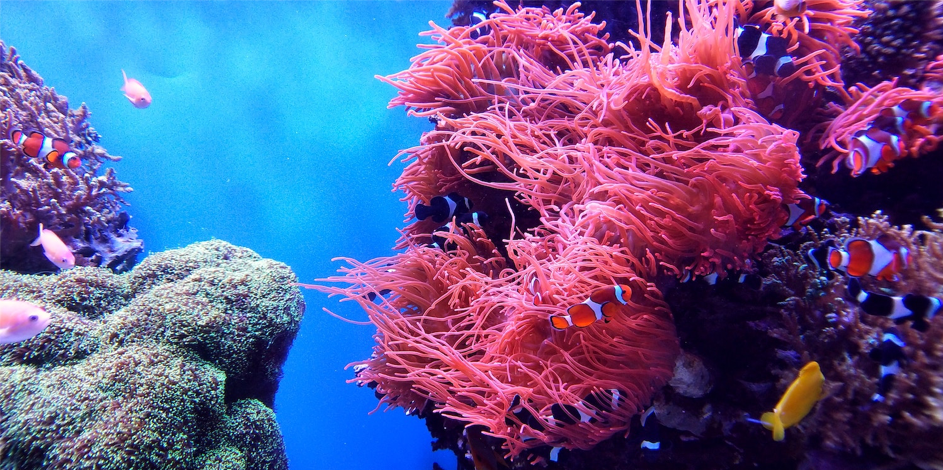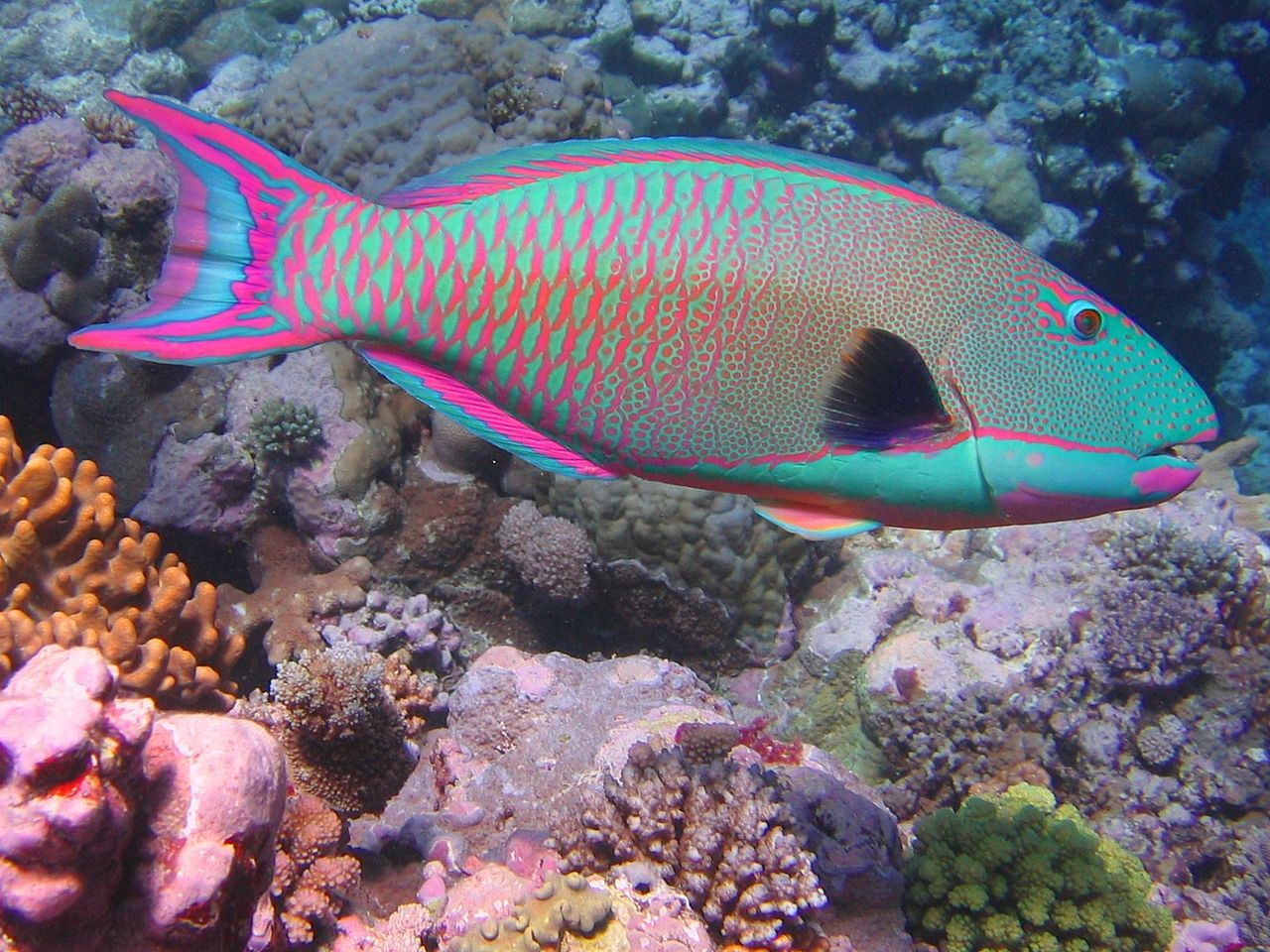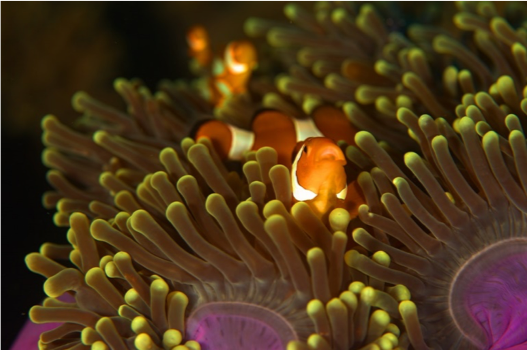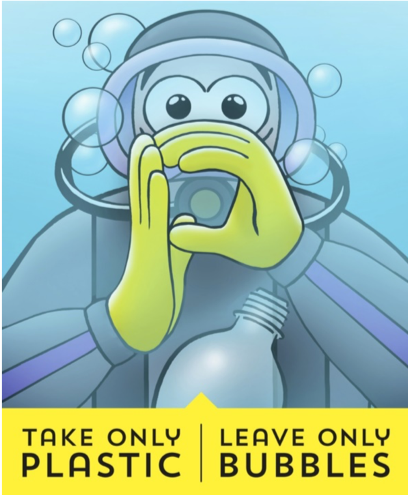Earth Law for Coral Reefs
Figure 1 by Li Fei via Unsplash.com
By Sonja Fortuin
Meeting coral reefs for the first time in person
It was a bright, sunny day on the beautiful coast of Mozambique and the day of my first ocean dive. The first attempt was horrible. Things that are effortless on land, like breathing and staying in one place, were a challenge below the surface. Everything inside me said: I never want to do this again.
Back on the boat I instantly got seasick. Luckily, we didn't have time to think. We had to go for our second dive immediately. During the descent I calmed myself with the idea of never diving again. But then I realized I could see everything bright and clear. Diving was amazing! Now I could clearly see the beauty around me: colorful fishes and corals, the sunlight breaking through the waves above me. Later I figured out that between dives I’d accidentally swapped masks with my friend. Seeing life clearly made all the difference.
Figure 3 Bright corals, by Milos Prelevic via Unsplash.com
On that second dive, I realized that I will dive for the rest of my life. If there is going to be something left to dive for… which brings us to coral reefs.
The awesomeness of coral reefs
The more I got used to the weird new dive gear, the more I realized how awesome coral reefs are. They are not only astonishingly beautiful, but also play a vital role in our ecosystem. Although they only cover around 0.2% of the ocean surface, they provide a home to 25% of all marine wildlife. They are the restaurants and nurseries for many species, including big ones that leave once they've grown enough to survive in the open ocean. Every dive I feel so grateful to get a glimpse of the daily life of this broad extremely biodiverse ecosystem. It’s so much more intriguing than I expected.
Keystone species
Some species have bigger impact on the state of the reef than others: the so-called keystone species. If this species disappears, the whole ecosystem will change. Corals themselves are actually keystone species, but there are more.
Parrotfish
Figure 3 Bicolor Parrotfish, by Richard Ling via Wikimedia Commons
When I started diving, I almost only heard my own breathing – and of course the bubbles that come with it. But as I got more confident under water, my breathing became calmer. What was that nibbling sound that I heard all the time? It sounded like someone was throwing tiny pebbles on even more tiny pebbles in a high frequency.
It was the parrotfish. You can recognize these famous keystone species by their bright colors (they always remind me of an eighties tracksuit, but prettier) and ‘parotty’ beaks. They are the garbage men of the reefs, working with great devotion and conforming to the latest standards of sustainability and circularity. They spend up to 90% of their time nibbling on dead coral and algae. And nothing goes to waste: they poop it all out as perfect white sand.
You can imagine what happens to your neighborhood when all the garbage men disappear. Coral reefs can die because of the lack of sunlight and the poison that is caused by an overgrowth of algae. We need our garbage men, reefs need their parrotfish.
Sharks
When it comes to sharks, most people will think of the famous and fierce white shark with its impressive number of sharp teeth that can easily kill a big sea lion. But the enormous and elegant whale shark is also a shark (and not a whale), and just feeds by keeping its mouth wide open while swimming and filtering out all the tiny creatures in its way. I had the chance to compare my swimming skills with this magnificent creature, and it outswam me without any effort.
Figure 4 Whaleshark, by Sebastian Pena Lambarri via Unsplash.com
Most sharks, however, are smaller in size and feed on intermediate size sea life. They tend to hunt old, sick, or slow animals, which leads to healthy populations of a healthy size. The presence of sharks also influences the behavior of animals. In Hawaii, scientists found that tiger sharks had a positive impact on sea grass beds. Without them swimming around, turtles (which are their prey) would spend all their time grazing on the most nutritious sea grass, until the habitat was destroyed.
Strong allies
I must admit, I used to think that fish didn’t have a rich social life. But underwater I could see interaction between sea creatures, within or in between species. Some species have created a very special bond and live in a beautiful symbiosis.
Clownfish & Anemone
My first dives were at a dive site called Clownfish, famous for its… clownfish. These bright, happy looking fish are always seen close to their anemone. The anemone stings every creature that comes close, except its own inhabitants. These inhabitants, which can only be clownfish, couldn’t wish for a safer home and are of course willing to return a favor. They keep the anemone clean, scare predators (even divers!) away and provide nutrients with their waste.
Figure 5 Clownfish in 'its' anemone, by Sebastian Pena Lambarri via Unsplash.com
Clownfish are born gender neutral, later they become male or female. They live in hierarchic schools, led by a female who you can recognize by her slightly larger size and aggressive behavior. If she dies, the male highest in hierarchy turns into a female and takes the lead. These bright little fish are quite social and communicate with each other by clicking sounds. You can imagine how disturbing a boat’s engine, coral blasting or seismic testing would be for them.
Pistol & Goby
‘Pistol & Goby’ sounds like a nice café, doesn’t it? It is another effective partnership that can be found at reefs, although my dive instructor had to point them out for me as they’re not the most flashy animals to be found. The pistol shrimp is very hard working but nearly blind. It spends its time digging and maintaining a nice burrow in the sand, with a kitchen garden on top. As it doesn’t have the time nor ability to look out for predators, the goby keeps watch. The couple ensure they stay in physical contact via the antenna of the shrimp. When Goby spots a potential predator, it waggles its tail to warn Pistol. Pistol rushes inside, and Goby follows soon after.
How did Pistol get his name? He’s got one very big claw that he uses like a pistol. When he sees a tasty meal, he fires a bubble bullet at it with a speed up to 62 miles/100 km an hour.
Harlequin & Starfish
Figure 6 Harlequin Shrimp, via Wikimedia Commons
The beautiful Harlequin shrimps mate for life and love to eat starfish. The couple work together on catching the starfish and twisting it around on its back, which renders the starfish helpless. Often, they drag it to their lair, feed it, and eat only one leg, to keep the starfish alive. The leg will grow back on, so it’s quite gruesome but sustainable farming.
Threats to coral reefs
A coral reef is a beautiful but fragile ecosystem of coral polyps, algae, plankton, fish, minerals, crustaceans and many other forms of life. I’ve seen some bleached coral reefs with only a couple of fish swimming around in search of something interesting. A terrifying contrast to the bursts of biodiversity that we love to see. Human behavior affects coral reefs in many ways, such as:
Rising temperatures
High water temperatures lead to the loss of microscopic algae, which are responsible for feeding the corals and for giving them their bright colors. A temperature rise of 1.5°C will lead to an estimated 70%-90% loss of all coral reefs. An increase of 2°C means we’ll lose 99% of it.
Ocean acidification
High levels of carbon dioxide make the seawater more acidic. This makes it harder or even impossible for corals to harden their calcium carbonate skeletons.
Overfishing
One of the most obvious threats: the fishing industry. Overfishing disrupts the coral reef’s ecosystem, especially when the targets are keystone species.
Pollution
Plastic is one polluter that has received a lot of attention lately. But also, other chemicals (from those used in industries to sunscreen) and sound pollution can damage coral reefs and disturb their ecosystem.
Invasive species
Species that have travelled, e.g. by boat or a floating piece of plastic, from one reef to another can disrupt the ecosystem of their new habitat. Famous examples are the beautiful but brutal lion fish and the rapidly spreading crown of thorns.
Physical damage
Boats and divers can break corals. This happens often unintentionally, with anchors, fins or other dangling objects.
But enough bad news, let’s see what we can do!
Earth Law
Despite many decades of marine protection and legislation, half of the world’s coral reefs have disappeared. So clearly protections need to evolve, to keep pace with the destruction. As with many previous rights-based movements around the world, the worst abuses of disenfranchised groups only stopped when those groups gained legal rights.
Earth Law recognizes nature’s right to exist, thrive and evolve. The belief that nature — the species and ecosystems that comprise our world — has inherent rights has proven to be a galvanizing idea. Earth Law Center is building an international movement that gives a better (legal) grounding to the idea that humans have a responsibility for how we impact the world, and works with local communities to help them to protect their environment from the threats that they see.
Earth Law Governance
Earth Law governance requires different decision making than the type we’re used to. The starting point should no longer be the interests for humanity in the short term, but the inherent rights of the ecosystem in the long term. This means that decisions should be based on the precautionary principle and the true costs of an activity.
For coral reefs, the precautionary principle means that conservation of the whole reef’s ecosystem is the most important objective in the decision-making process. The true costs of diving activities depend highly on their impact on the reef. For example, dive trips on boats with a noisy and polluting engine cause more harm to the reef than silent sailing boats. Giving a score to different types of activities helps in making well-informed decisions.
This type of governance has been laid out in the framework for Marine Protected Areas, that Earth Law Center already developed. You can also read more about Ocean Rights here.
Successful Case Studies of Reef Conservation
Reef protection is more than a theory. There are governments, NGO’s and local communities that have already set examples on how this can be accomplished. Of course, every ecosystem which includes humans has its own characteristics, problems and thus appropriate solutions. A reef on which a whole fishing community depends on, asks for different governance than a reef that lies next to a polluting, prosperous city. But we can surely get some inspiration from what front runners have done already!
Figure 7 Palau, via Wikimedia Commons
Palau
The little islands of Palau form a heaven for the diving community, and they’re high on my wish list as well. Luckily, the president of Palau puts a lot of effort into protecting the reefs and even asked the United Nations for their support.
Have you ever heard of a Bul? It’s also known as a fishing moratorium, which means that fishing is prohibited during spawning and feeding periods. This way, the fish populations can recover. The president of Palau called out a life-long Bul: commercial fishing is banned completely in their Marine Sanctuary as of 2020. Eco-tourism, and especially diving, ought to compensate the loss of income because of this ban. It already forms over half of Palau’s GDP.
Introducing a new law is one thing, but enforcing it is a second challenge. Especially when it concerns patrolling big parts of the ocean, which is the case of Palau with its area the size of France. Palau is now using drones to monitor if there are any vessels in their Sanctuary that shouldn’t be there.
Belize & Co.
Remember the awesome parrotfish? After the International Society for Reef Studies recommended Mesoamerican Reef countries to better protect these ‘bison of the ocean’, Belize was the first to respond by introducing a law that prohibits their catch in 2009. Belize was followed by Bay Island, Honduras in 2010, Guatemala in 2015, and Mexico in 2018.
And the positive effect has been proved! Since 2006, the amount of parrotfish in the Mesoamerican Reef increased, and the first slight decline in fleshy macroalgae was noticed in 2018. The coral cover has also increased over this period of time, although the cover varies every year. Overall, the Reef Health Index improved from 2.3 to 2.8 (out of 5).
Belize continued its efforts by preventing trap fishing and announced it would triple the size of its no-take zones as well as ban single-use plastic and Styrofoam products. Last but not least: they banned offshore oil exploration and drilling. Go Belize!
Thailand
Tourism can be a good (alternative) livelihood for local communities. But mass tourism can cause mass destruction. The popular Maya Bay in Thailand, known from the movie The Beach, was visited by thousands a day. Boats damaged the reef and the black tip reef sharks disappeared. The government decided to close the area for four months. A couple of months after Maya Bay had been closed, the black tip reef sharks returned!
But four months weren't enough to fully restore Maya Bay's nature. Therefore, the officials decided to close the beach indefinitely.
Indonesia
It’s not only up to governments to help coral reefs. In Indonesia, a local fishermen’s forum discussed the problem of catching increasingly smaller fish. They had to put more and more effort into fishing, and used more and more brutal catching tactics. As a solution to their problem, the fishers decided to reduce the catch of rabbitfish, a keystone species comparable to the earlier mentioned parrotfish. In their key spawning months, September to December, the fish were left alone for four days around the full moons. And guess what? Their population rebounded!
The impact of divers
The Mozambican coastal village of Tofo used to be a quiet place where most people depended on fishing for food and income. With the arrival of the diving industry, Tofo became an attraction for people who rather see fish alive under water than dead on their plate. In order to provide an alternative livelihood, fishermen get trained for a diving job. Many former fishermen told me that they had no idea how pretty life under water was. And that they really prefer seeing ocean creatures in their natural habitat (and sharing this experience with others) over catching, killing and selling them. But there are also stories about too many divers diving at the same time, leaving the reef damaged.
Diving at different places with different dive guides, made me realize that diving can have both positive and negative effects. It gives people the opportunity to get to know and love the underwater world. But of course, giving people access to a new world also means that this ecosystem is confronted with new threats. How can divers make a positive impact?
Dive destination
Many interesting dive sites are located in exotic areas. Your decision on where and with who you dive, can make a difference. Besides paying attention to the distance of the destination (going by airplane is unfortunately not very climate friendly), you can also have a look at how dive centers treat the reefs, the local community and the rest of their environment.
Respect underwater life
When I started diving I assumed that all diving professionals have a great passion and respect for the underwater life. Most of them do. Their faces shine when they talk about the ocean's creatures, they show you which hand signs they use to point them out, and emphasize that you shouldn’t touch anything.
But unfortunately, I’ve experienced dive guides who see diving more as ‘just a job’ and a great opportunity to hit on customers. Such a dive guide thinks you are impressed when he pokes a puffer fish until it bloats up, picks up a sea cucumber to show how stretchy it is, or annoys a Red Sea Walkman until it starts walking. If you experience this, please tell them that you prefer to see the creatures in their natural behavior.
P for Plastic
The first time I saw a turtle under water I remember very well. My dive instructor pointed just in front of me, and at first, I didn’t understand what I should see. But then this giant turtle came out of his little cave, right in front of me! I literally floated up of excitement, as a deep breath makes you positively buoyant and causes you to go up. These amazing graceful, peaceful creatures can’t tell the difference between their favorite jellyfish-meal and a plastic bag. When they ingest plastic, it makes them more buoyant. Guess what, it also causes them to float up. And more importantly, it can make it impossible for them to dive down after they surfaced to take a deep breath. This leads to starvation.
There are many other devastating stories about the impact of plastic. I’m sure you have seen pictures of fish, turtles, birds or other animals that are entangled with plastic. Floating pieces of plastic transport toxins and eggs of invasive species from one reef to another, tiny pieces of plastic (micro plastics) get ingested by even the tiniest sea creatures and become an increasingly big part of the food chain (of which many people are part of).
An estimated 80% of all plastic in the ocean, comes from land. Luckily, the fight against plastic has started. Over 40 countries have (partially banned) or taxed single use plastic bags. Kenya has one of the boldest bans: producing, selling or even using a plastic bag can lead to a maximum imprisonment of four years or a fine up to $40,000. Bali had such a huge problem during the rainy ‘plastic’ season, that it banned all disposable plastics. As of 2021, single-use plastic items such as plates, cutlery, straws, balloons, sticks or cotton buds will be prohibited in Europe.
Especially for divers, a new underwater hand signal was introduced by a collective of divers, dive shops and the Plastic Soup Foundation. By making a P for Plastic, divers can show their buddy that they see some plastic and they want to pick it up. Together we keep our oceans clean!
Figure 8 P for Plastic by Plastic Soup Foundation
Sustainable Sunscreen
When you’re out at sea, it’s of course important to protect your skin from sunburn. Unfortunately, about 60% of all sunscreens on the market contain oxybenzone and octinoxate. These chemicals disrupt the growth cycles of coral and can eventually lead to bleaching. It also causes behavioral problems and feminization (males turning into females) among fish. The chemicals don’t only come off when you swim with it, but can also end up at the reef after you've taken a refreshing shower.
Hawaii, Palau, Bonaire, Key West, and various other tourist destinations have banned sunscreens which damage coral reefs. And no worries, there are plenty of options to protect your skin against UV without damaging under water life. But the most environmentally friendly way to protect your skin, is to cover it with clothes.
Marine research
Diving makes it possible that marine biologists can collect relevant data for their much-needed research. I joined a citizen science project and collected data about the underwater life (and about plastic on the beach). By continuously letting divers note down certain keystone species they have seen, the health of the reefs stays monitored over a long period of time. There are also dive centers that let marine researchers join their commercial diving trips for free.
So, if you want to dive again, maybe you could consider contributing to marine research. This can be as easy as reporting your sightings via an online database, for example for whale sharks. And if you can choose from different dive centers, why not choose a dive center that supports research?
Time for change!
There are signs that things are changing. Sixteen countries, representing over 55% of all coral reefs in the world, have signed The Coral Reef Declaration. These countries agree to support the health of coral reefs in a broad sense, by fighting climate change, drawing attention to the role and fate of reefs, supporting research, etc. Unfortunately, the agreement is not binding. But this might change as soon as coral reefs get their well-deserved rights of their own.
Luckily, we don’t have to wait helplessly for something to happen. You can start making a change immediately, by…
Respecting the ‘personal space’ of marine life
Using bio-degradable sunscreen and cleaning products
Asking dive centers for their code of conduct
Picking up plastic (underwater only after signaling your buddy)
Choosing your dive destination carefully
In general: reduce, reuse and recycle!
You can also:








